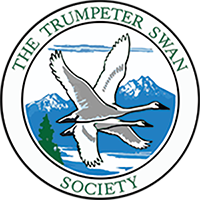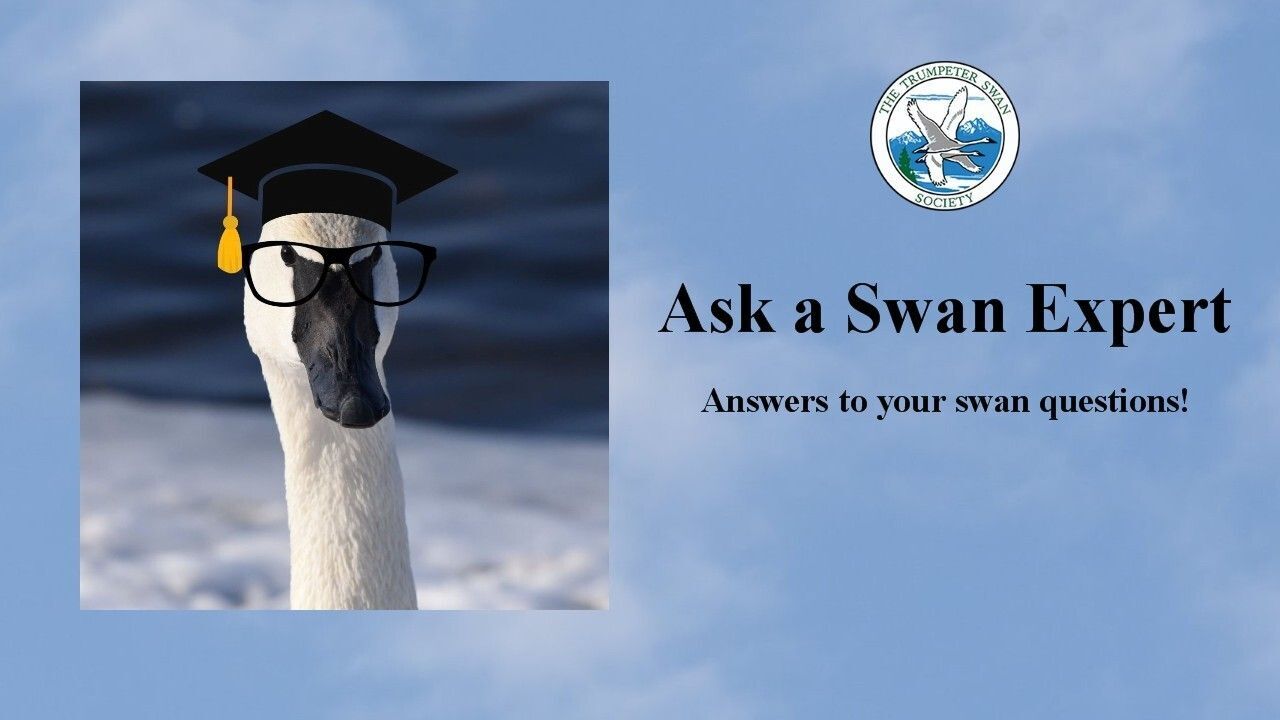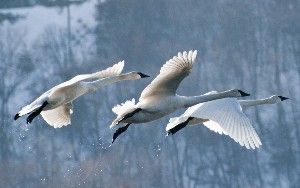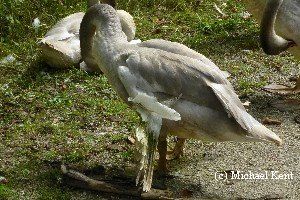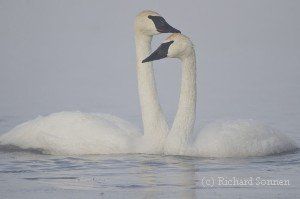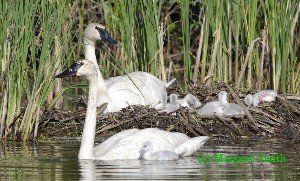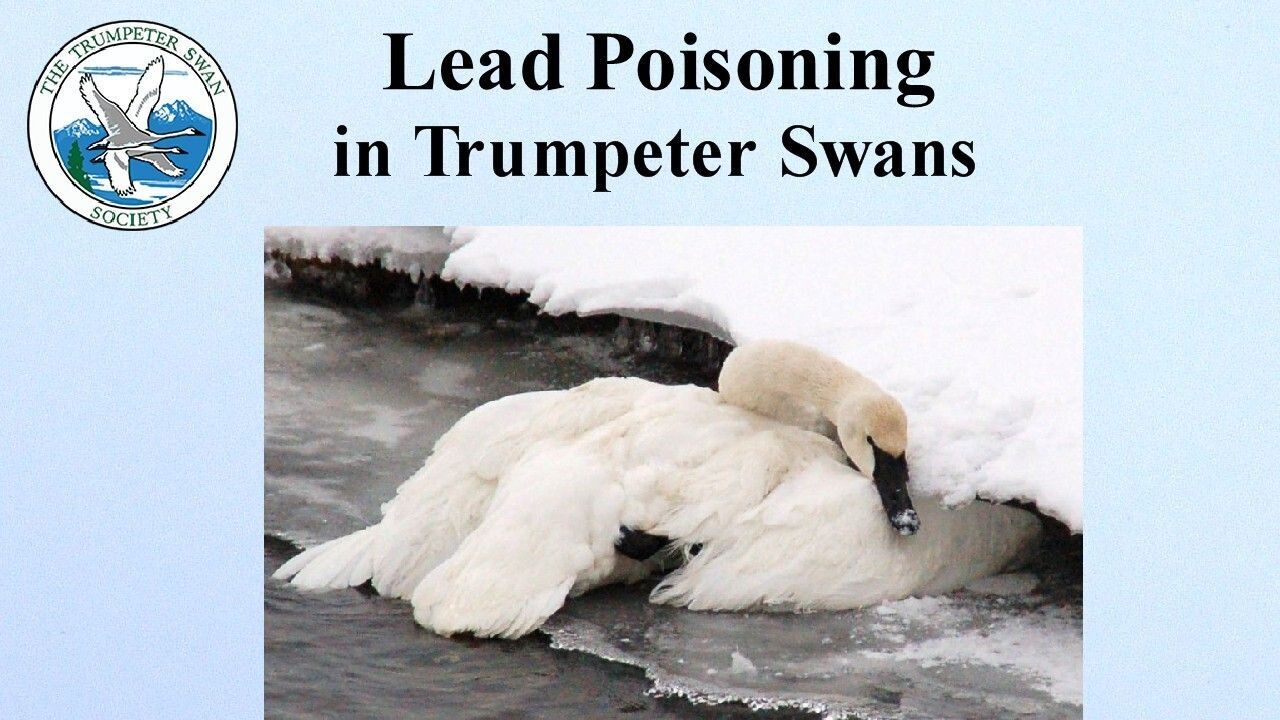Photograph by Margaret Smith
Frequently Asked Questions
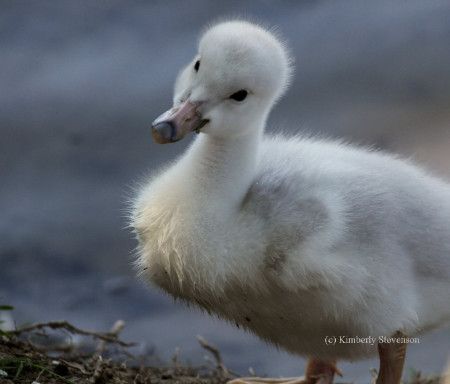
"Inquisitive" Photograph by Kim Stevenson
Do you have a Trumpeter Swan question? Here are some of the most frequently asked questions. Do you have a question not on the list? You can e-mail your questions to us and we will do our best to answer them or find someone else who might know the answer.
Frequently Asked Questions
- Where can I see swans?
- Where should I report seeing a Trumpeter Swan?
- Should I feed wild Trumpeter Swans?
- Are Trumpeter Swans an Endangered Species?
- What are male, female, and young swans called?
- How can you tell a male from female swan?
- Do Trumpeter Swans mate for life?
- What do Trumpeter Swans need for nesting?
- How many eggs do Trumpeter Swans lay?
- When do Trumpeter Swans learn to fly?
- Why do swans have stained heads and necks?
- What do Trumpeter Swans eat?
- What are the main predators of swans?
- How long do Trumpeter Swans live?
- How can I tell if the swan I see is sick?
- How can I attract swans to my private wetland?
- Will Trumpeter Swans remove geese from my lake or pond?
-
Our Trumpeter Watch "Report a Swan" page has links to Ebird maps of Trumpeter Swans across North America, a downloadable list of National Wildlife Refuges with Trumpeter Swan habitat, and a downloadable list of zoos with Trumpeter Swans. Report a Swan page has a quick and easy online reporting form for your swan sighting to TTSS. Photograph by Richard Sonnen
-
Seeing a Trumpeter Swan for the first time in a new place is very exciting! Seeing and reporting a swan with a neck collar or leg band is very helpful and strongly encouraged. Report your swan(s) to the Bird Banding Lab and to our Trumpeter Watch program.
-
We do not encourage feeding of wild Trumpeter Swans. Please do not feed swans bread, crackers or other "human food". Trumpeter Swans eat the roots and tubers and other aquatic plants they find in shallow waters and those natural food sources are their best nutrition. Feeding swans "human food" or food that is rich in protein and calories can also contribute to "angel wing", a deformity of the wings which permanently prevents swans from flying. Photograph of cygnet with "angel wing" by Michael Kent. Watch our Facebook video of this cygnet with angel wing to better understand "angel wing" and how you can help prevent it (click on "Should I feed wild Trumpeter Swans?").
-
Are Trumpeter Swans an Endangered Species?
In the 1930s, only 69 trumpeters were known to be alive in the United States and those were all in Yellowstone and the Centennial Valley of Montana. That discovery led to the establishment of Red Rock Lakes National Wildlife Refuge. Those birds were sheltered from trapping and hunting due to the remoteness and harshness of the region. Swans were able to survive through the cold in these regions thanks to ice-free areas created by hot springs and geysers. In the late 1930s, biologists began moving some of those trumpeters to other western refuges. Unknown to the U.S. biologists at that time, there was another area, Grand Prairie in Alberta, Canada, where a small flock of trumpeters also survived. Additionally, after Alaska became a state, more trumpeters were discovered, and a survey in the 1960s found more than 2,000 there.
The Trumpeter Swan was never on the Endangered Species List, but was included in the Red Book listing of species being considered for Endangered Species status through the Endangered Species Act. However, the discovery of Alaskan trumpeter swans led to trumpeter swans being removed from the U.S. endangered species list in 1968, before the Endangered Species Act of 1973. However, various states list the Trumpeter as either state-threatened or state-endangered.
-
What are male, female, and young swans called?
A male swan is called a Cob. The female is called a Pen and the young of the year are called cygnets (pronounced 'sig-nets').
-
While male Trumpeters (21-38 pounds) are generally larger, weigh more than female Trumpeters (20-25 pounds), visually distinguishing the sexes is not possible without internal examination of the vent area. However, an observer can tell the sex of each bird of a pair by watching their behavior. It is only the female that incubates the eggs while the male will swim close by to protect the nest from predators. In mating, the male mounts the female and grasps her neck with his bill. Learn more in our Swan Identification and Swan Behavior Sections. Photograph by Richard Sonnen
-
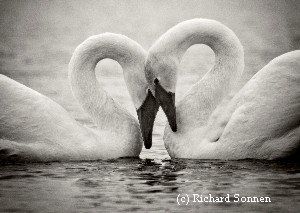 Do Trumpeter Swans mate for life?
Do Trumpeter Swans mate for life?Trumpeter Swans form very strong pair bonds with their mate. The pair will remain together under most circumstances. If one of the pair dies, the remaining mate will often find a new mate. Sometimes, if a pair is unsuccessful in breeding for several years, they may find new mates. For the most part, swan pairs are very loyal to each other. Photograph by Richard Sonnen
-
Trumpeter Swans "trumpet the cause for wetlands" and wetland conservation. Nesting Trumpeters require shallow wetlands with abundant food, good nesting islands, minimal human disturbance, ice free water from at least late April to October, and lack of contaminants. The nest is often in a secluded area and being surrounded by water is preferred to be alert to predators. Nests can be built on muskrat houses, or can be built from reeds, grasses and cattails into mounds that rise above the water. Swans do not nest in trees.
Observing nesting swans is a good way to identify the female and male swans. It is only the female that incubates the eggs while the male will swim close by to protect the nest from predators.
The Trumpeter Swan is a wonderful high profile ambassador for the importance of wetland conservation. When we protect and improve their habitat, many less conspicuous species, whose existence also depends on conservation of high quality wetlands, also benefit. Do you want to attract swans to your property? Download the document and learn best practices. Photograph by Margaret Smith
-
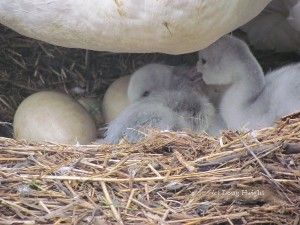 How many eggs do Trumpeter Swans lay?
How many eggs do Trumpeter Swans lay?Trumpeter Swans lay, on the average, three to eight eggs. Eggs are typically laid in April/early May, with hatching sometime between May to mid-to late June, depending on the geographic location and warming weather. One egg is laid every other day until the clutch is complete. The Pen does not begin incubating until her clutch is complete so that all cygnets will hatch within 24 hours of each other. Only one clutch of eggs is laid per year, although if a nest is destroyed, the pair may try to breed again, usually not successfully. The incubation period is approximately 34 days. The swans build their nests out of stems and leaves from plants such as cattails and sedges. Trumpeters often nest on top of muskrat houses or beaver lodges. Photograph by Douglas Haight
-
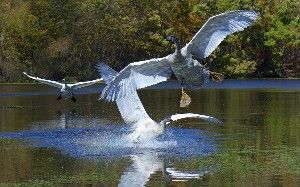 When do Trumpeter Swans learn to fly?
When do Trumpeter Swans learn to fly?Trumpeter Swan cygnets learn to fly (fledge) when they are about 3 to 4 months old. This is in September or October of the year. They are awkward flyers at first. Powerline collisions are a major source of death during the first few months of flight. The young swans spend their first winter with their parents. By the time spring arrives, the young swans, now almost a year old are much more adept at flight and avoiding powerlines. "Cygnets first flight" photograph by Eileen Sabes
-
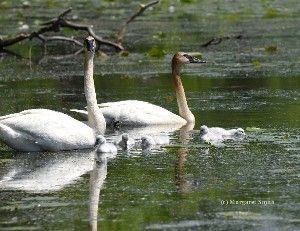 Why do swans have stained heads and necks?
Why do swans have stained heads and necks?Trumpeter Swans spend a great deal of time feeding on plants and roots buried in the sediment of wetlands, rivers and lakes. The tannins and other minerals in the water stain the white feathers on the head, necks and even breasts of swans. You may often see them in "tip up" with their tail ends pointing up above the surface of the water while the rest of the body is submerged under the water to feed. Photograph by Margaret Smith
-
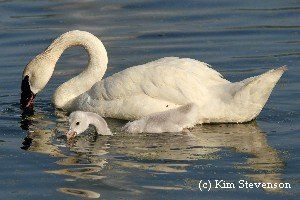 What do Trumpeter Swans eat?
What do Trumpeter Swans eat?Adult swans eat aquatic vegetation, including the leaves, seeds, and roots of many types of pond weeds. Tubers and rhizomes of various aquatic plants are staple foods.
Swan parents do not feed their young like other birds do such as robins which put food directly into the mouth of their young. Parents use their feet to stir up food in the sediment for cygnets. Cygnets eat the food directly (see photo). You may see a swan parent rock back and forth as its feet dislodge plants in the sediment which rise to the surface. Young cygnets also eat invertebrates, a source of protein for early growth. Invertebrates found in the sediment with the tubers/rhizomes also provide protein to adults and cygnets. Some of the plants swans are known to eat, according to Winston Banko, include pondweed (Potamogeton), water milfoil (Myriophyllum), musk grass (Chara), waterweed (Elodea canadensis), duckweed (Lemna trisculca), spatterdocks (Nymphaea polysepala), bur- reeds (Sparganium augustifolium), wapato (Sagittaria cuneata), Carex rostrata and arrowhead. Wild swans are also adapting to field feeding, eating left over grains and vegetables following harvest by farmers. Photograph by Kim Stevenson
-
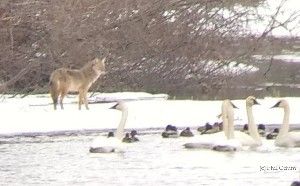 What are the main predators of swans?
What are the main predators of swans?During the first few months when cygnets are small, the main predators are mink, coyotes, bald eagles, great horned owls, and snapping turtles. Larger cygnets and swans may be attacked and killed by coyotes, otters, bobcats, eagles, unrestrained dogs, and humans (poaching). "Coyote and swans" Photograph by Phil Odum
Read "My Swan Story" by Bill Q. in the sidebar and learn first hand what it was like to see a swan and coyote dispute from a small bush plane in Alaska. -
In the wild, Trumpeter Swans can live up to 20 or more years. A well-known male Trumpeter Swan at Turnbull National Wildlife Refuge in Washington lived more than 35 years (read the story of "Solo" by clicking on the blue text).
Most swan deaths occur during the first three years. On average, about 50% of cygnets may not survive the first three months after hatching, due to predation by snapping turtles, eagles, coyotes, mink, and other predators. Another 25% of swans may perish before they are three years of age. However, swans surviving their first three years are likely to live many years. The most frequent causes of death for mature and experienced swans are powerline collisions, lead poisoning from ingestion of lead fishing tackle or ammunition, and poaching (illegal shooting).
-
Animals that are sick tend to isolate themselves. A swan may possibly be ill if you see the following:
1) being alone for several days
2) not flying or appears to have difficulty in flying
3) has difficulty in holding its head upright
4) appears lethargicIf you see a swan that appears to be sick, contact your nearest wildlife rehabilitation center for their recommendations.
Want to learn more? Watch our video, "Lead Poisoning in Trumpeter Swans" to learn how to recognize a sick swan, how to safely capture it, and its diagnosis and treatment at a wildlife rehab center.
-
How can you attract nesting Trumpeters? Sometimes the work involves constructing a new wetland or improving an existing site.
Sometimes, nothing more is needed than to prudently curtail human activities in the pond vicinity. This gives Trumpeter Swans adequate security for nesting and brood rearing. Can you imagine the thrill of fledging wild swans as the fruit of your labors and waiting eagerly for their return in the spring?
If you live in an area where Trumpeters nest and would like to explore the potential for your wetland to support successful nesting, helpful information is here.
Two of Wyoming's foremost Trumpeter Swan biologists have written a wonderful guide for improving swan nesting wetlands that we highly recommend. Click on the blue text for the guide.
-
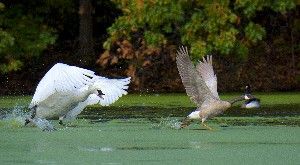 Will Trumpeter Swans remove geese from my lake or pond?
Will Trumpeter Swans remove geese from my lake or pond?Only a mature, mated territorial nesting pair of Trumpeters will chase off (they might even kill) geese and other waterfowl in their nesting marsh. However, this aggressive behavior is usually only exhibited during the nesting season March through October. At other times of the year, the swans will readily flock with the geese. Young swans or two swans of the same sex will not be as aggressive and generally will readily tolerate geese and other waterfowl at any time of year.
Captive swans need open water year round and will need to be fed during the winter months which could attract waterfowl. Early in the season, a trained dog may be more effective to chase geese off the lawn. However, once the geese begin nesting, they are protected under Federal Migratory Bird law and may not be harrassed. In order to discourage geese ( and promote healthier wetlands), it is best to keep a good natural buffer around the pond, allow grass to grow long, and plant shrubs. Geese do not like to eat long grass! They love to eat freshly mowed grass. A fence barrier between your lawn and the lake should also discourage them. Geese prefer a clear runway to the pond and a clear view to spot potential predators. Finally, encourage your neighbors not to feed geese!
Photograph by Eileen Sabes
Learn more about adult and juvenile swans
